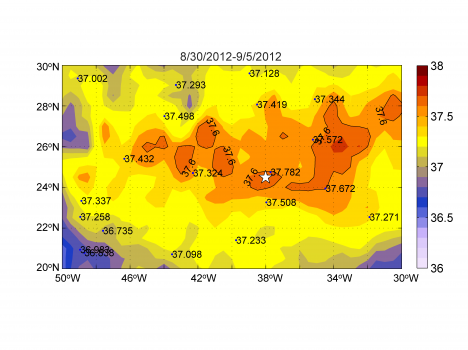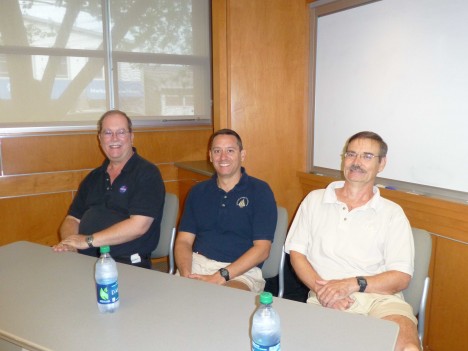

By Eric Lindstrom
SPURS Chief Scientist Ray Schmitt has been thinking about the salt in the ocean for a long time. He did his PhD thesis on an unusual form of mixing called “salt fingers,” which we will discuss in a later post. This small scale mixing process led him to consider the origins of the ocean salinity contrasts that we see around the world.
It’s fairly obvious that salty waters arise from high evaporation regions and fresher waters originate from high rainfall areas or river flows into the ocean. But it turns out that accurate estimates of evaporation and rainfall over the ocean were hard to come by. For a long time, it was a relatively neglected research topic. Many meteorologists were only concerned about how much it rained on land and few seemed to care if it rained on the ocean. Pulling together the best data he could, Ray found that, in fact, the ocean completely dominated the global water cycle. The terrestrial part, so important to us on a daily basis, is a much smaller piece. The oceans hold 97 percent of the Earths free water, the atmosphere only 0.001 percent. The oceans provide 86 percent of global evaporation and receive 78 percent of all rainfall. The total of all river flows into the ocean sums to less than 10 percent of global ocean evaporation. Clearly, if one wants to find out what the water cycle is doing, one should be looking at the oceans. The traditional fixation on the terrestrial water cycle is understandable, but risks missing the big picture. It seems that the tail is wagging the dog in terms of research on the global water cycle!
Of course, one of the most important questions for climate change is what the water cycle will do with continued warming. Basic physics tells us that a warmer atmosphere will hold more water vapor, so an intensified water cycle is expected. Oceanographers should be able to assess any trend in the water cycle if we do a good job in monitoring ocean salinity. On land, man has altered every watershed with dams, groundwater irrigation, deforestation and human consumption. But the ocean’s mostly unaltered and its salinity field provides insight into the vast majority of the pristine natural water cycle. The ocean has its own rain gauge in the form of salinity, and our task in SPURS is to learn how to read it.
The combination of the global coverage from Aquarius for surface salinity, detailed process studies in the ocean like SPURS, and sophisticated high-resolution computer models working in concert open up the oceanic water cycle to careful scientific examination.

Aquarius salinity data from the first week of September 2012. (Credit: Oleg Melnichenko at University of Hawaii IPRC.)
We are beginning to deploy the array of instruments on the ship and they are starting their year-long mission to examine the ocean salinity variations. Our challenge is to understand the detailed picture of salinity that will be painted by the various sensors and to make sense of this in the larger picture of the global water cycle.
By Eric Lindstrom
We knew when we left Woods Hole yesterday that we had two hurricanes (Leslie and Michael) standing between us and our study site, far southeast of Woods Hole in the mid-Atlantic. How Captain Adam of the Knorr chooses to deal with this over the next days is a study in weather and ocean forecasting – and calculated risks. We considered at least three options: delay departure until the coast is clear, make a significant departure to the cruise track (sail far south, then east), or leave on time but travel quickly to the east and then south to miss the worst of the hurricane weather.
The last option is what we are doing. We abandoned plans to do test stations and do science training for a few days so we can make hast to the east, to the east side of Leslie’s track. Then we can make our way south and around Michael. Tom Farrar and Fred Bingham of the SPURS science team have provided the bridge with Gulf Stream analyses that we hope will help us take best advantage of ocean currents in our race eastward. We could easily have found ourselves in an eddy that would hinder our progress, and no one wants that with bad weather coming toward us! It was a fabulous start to the voyage to have the crew of the Knorr and the SPURS team working so closely on the strategy to both keep us safe and on schedule.
It’s worth mentioning too that satellite data and the shore-based team play a crucial role in our cruise planning. Zhinjin Li and Michelle Gierach at the NASA Jet Propulsion Lab have been feeding us the latest satellite images from the Atlantic so we can better understand the wind, waves, and currents in our path. We rely on these contributions because it is difficult to surf the web from sea – we have Internet access, but it can be quite slow.
Today we feel the enormous forces of the tropical storms on the western Atlantic. There is a good swell running – speaking clearly of some strong wind at a distance. Some aboard are feeling seasick, but the mess is still full of hearty eaters and smiling faces!
One of the things you notice in these conditions are all the items that can shake, rattle, squeak, groan, or otherwise move and make noise. I have been up and down in my cabin a number of times during the night to silence rattling cupboard doors, toppling books, sliding glasses – it’s almost an endless battle. At sea you don’t just put something down – you secure something, wedge something, pad something, or it becomes something broken, lost, dangerous or just plain noisy! Sometimes one even has to wedge oneself in a place and just stop moving around! All of us have greater appreciation than most for the stability of land and the silence that stability brings. When things are shipshape, all is secure and in its place. We are living shipshape today.
By Eric Lindstrom
We had a whirlwind of preparations after the Labor Day Weekend. All the gear was loaded on the ship and lashed down. The scientific party (22 people) arrived and set up in various spaces around the ship. Bill Ingalls, a NASA Headquarters photographer, captured many great shots of the Knorr and the equipment. His photos are online at NASA Headquarter’s Flickr account.

SPURS researchers held a press conference the day before departing. From left to right: Eric Lindstrom, Dave Fratantoni and Ray Schmitt,
I also had the pleasure of meeting Naomi Harper, a teacher from Will Rodgers Middle School in Fair Oaks, CA. She was visiting Woods Hole and stopped by the ship. I am looking forward to interacting with her students via this blog during the voyage.
We cast off and set sail at 8:30 a.m., on Thursday, Sept. 6. While it’s a very beautiful calm day, we know that we have storms in the Atlantic between us and our destination (Hurricanes Leslie and Michael). The cruise plan is being adjusted a little so we spend the first few days focused on “outrunning” the storms. We can do out test stations and other such preparations after we have reached calmer waters west of the hurricanes. So, we are expecting rough seas at some points during the next few days and the first order of business as we set sail is to get all our gear secure on deck and in our cabins. Everything that can move needs to be secured before we face the storm waves.
[youtube dcJOl8hYJhM]
There was a nice gathering of friends and family at the wharf to see us off on our voyage. We are lucky to have such a beautiful sunny morning and calm winds for the send-off.
Thirty minutes after setting off from Woods Hole, we have our first meeting of the entire scientific party. There are people from several institutions and we all need to put names to faces. There are also scheduled safety meetings and boat drills during our first day and before we leave the calm waters of Massachusetts behind.
The only scientific work planned for the first few days, as we race past the storms, is regular sampling of surface waters to calibrate the ship’s thermosalinograph. This instrument monitors ocean temperature and salinity continuously from water coming in through a port in the ship’s hull. It will operate continuously during the voyage, but we need to collect calibration samples every 4 hours for precision salinity determination.
We are all learning about the rhythms of shipboard life. We will have people on many different watch schedules. The watches will operate on local time. That shifts as we move east across time zones. As your blogger on the SPURS cruise, I plan to float across different groups and schedules as the expedition progresses to give you multiple perspectives. On the ship, meal times are very important. We will have breakfast every day from 7:30 to 8:15 a.m., lunch from 11:30 a.m. to 12:15 p.m., and dinner from 5:00 to 5:45 p.m. I’ll let you know more about the delicacies we eat at sea!